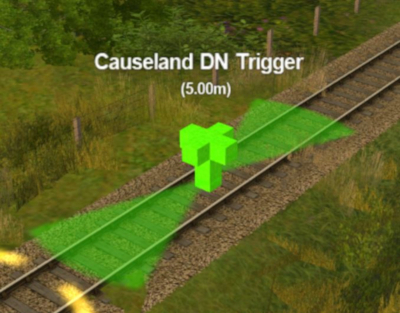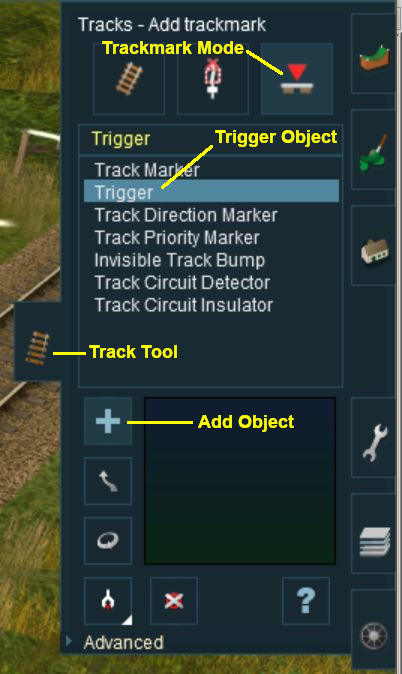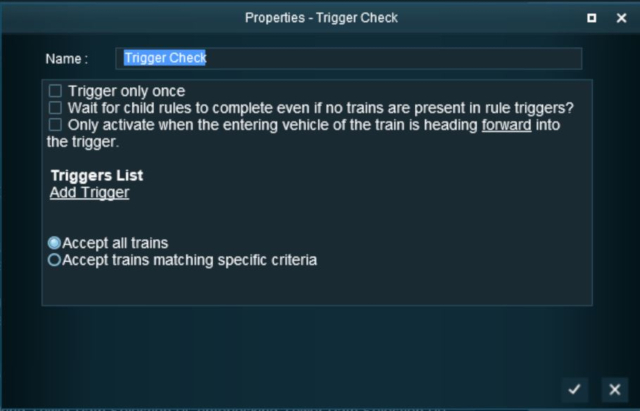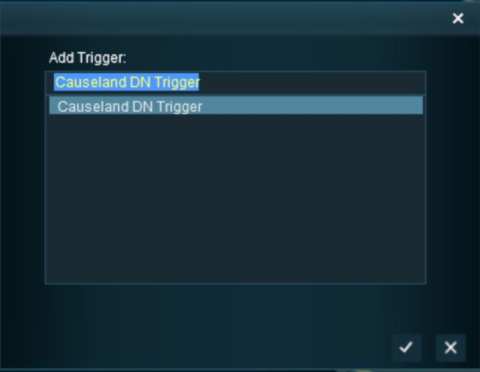How to Use Track Triggers
m (→What are Triggers?) |
m (→Adding a Trigger) |
||
| Line 18: | Line 18: | ||
<table> | <table> | ||
| − | <tr> | + | <tr valign="top"> |
<td>[[file:TrackTriggerMode.JPG]]</td> | <td>[[file:TrackTriggerMode.JPG]]</td> | ||
| + | <td>The '''Trigger Object''' is selected from the list of installed objects then the '''Add Object''' button is clicked followed by clicking the track position where the trigger is to be placed. | ||
| + | </td> | ||
</tr> | </tr> | ||
</table> | </table> | ||
| − | |||
| − | |||
*'''Configuring a Trigger''' | *'''Configuring a Trigger''' | ||
| Line 30: | Line 30: | ||
<table> | <table> | ||
| − | <tr> | + | <tr valign="top"> |
<td>[[file:TrackTriggerProperties.JPG]]</td> | <td>[[file:TrackTriggerProperties.JPG]]</td> | ||
| − | < | + | <td> |
| − | + | ||
| − | + | ||
*To change the assigned layer click on the layer box and select a new layer. | *To change the assigned layer click on the layer box and select a new layer. | ||
| Line 40: | Line 38: | ||
*To confirm the changes click on the '''Tick''' icon on the bottom right of the window. | *To confirm the changes click on the '''Tick''' icon on the bottom right of the window. | ||
| + | </td> | ||
| + | </tr> | ||
| + | </table> | ||
| − | Triggers have a "radius | + | Triggers have a "detection radius" that controls how close a train has to approach to trigger their event. The smaller the radius the closer the train. This radius is set in the '''Advanced Properties''' section of the '''Tools''' window. |
<table> | <table> | ||
| − | <tr> | + | <tr valign="top"> |
<td>[[file:TrackTriggerRadius.JPG]]</td> | <td>[[file:TrackTriggerRadius.JPG]]</td> | ||
| − | </tr> | + | <td>Click the '''Advanced Tab''' to open its properties. Enter a new radius value in metres, click the '''Set Trigger Radius''' button then click on the trigger. |
| + | </td></tr> | ||
</table> | </table> | ||
| − | |||
| − | |||
==='''Creating a Trigger Event'''=== | ==='''Creating a Trigger Event'''=== | ||
Revision as of 08:35, 20 May 2018
Contents |
What are Triggers?
Triggers are invisible markers (invisible in Driver Mode but visible in Surveyor Mode) that are placed on a track. They can be programmed to "trigger an event" when a train (any train or a specific train) passes over them in Driver Mode.
The "event" is a message that is transmitted by the trigger to certain Session Rules that have been programmed to "listen" for the message. When one of those listening rules detects the message, it can be forced into action by executing preset instructions.
 |
A Track Trigger in place on a track visible in Surveyor Mode. The "5.00m" is the trigger detection radius |
Adding a Trigger
The Track Trigger is placed on the track using the Tracks tool and Trackmark Mode.
 |
The Trigger Object is selected from the list of installed objects then the Add Object button is clicked followed by clicking the track position where the trigger is to be placed. |
- Configuring a Trigger
As soon as a new trigger has been placed, its properties window will open on the screen. It will be given a default name and assigned to the currently active layer.
Triggers have a "detection radius" that controls how close a train has to approach to trigger their event. The smaller the radius the closer the train. This radius is set in the Advanced Properties section of the Tools window.
 |
Click the Advanced Tab to open its properties. Enter a new radius value in metres, click the Set Trigger Radius button then click on the trigger. |
Creating a Trigger Event
Trigger events are handled by the Trigger Check Rule which is added to a session in the Session Editor.
- The Trainz Wiki Link Trigger Check Rule contains detailed information on this rule.
Start the Session Editor from the Surveyor Main Menu.
Select the option Edit Session from the drop down menu list.
 |
 |
Click the Add button. Scroll down to select the Trigger Check rule then click the Tick icon.
 |
This will add the Trigger Check rule to the session.
 |
With the Trigger Check rule highlighted, click the Edit button. This will open its properties window.
 |
For this example we will leave all settings unchanged and simply identify the trigger to be used. Click the Add trigger link and select the trigger you have previously added.
 |
Click the Tick icon on the selection lest and again on the Trigger Check properties window. Then exit the Session Editor screen.
To test your trigger event you will need to add rules to the Trigger Check. See the Message Popup Rule Applications page for an example.
